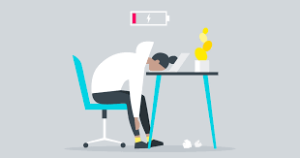
Overcoming Burnout – Tips for Restoring Your Energy and Well-Being: Signs, Causes & Strategies
In our fast-paced world, the prevalence of burnout has escalated across various lifestyles. Whether you’re a student, professional, or parent, understanding and addressing burnout is crucial. This chronic state of exhaustion goes beyond mere tiredness, impacting mental and physical well-being. Let’s delve into the intricacies of burnout, recognizing its signs, exploring root causes, and discovering effective strategies for overcoming this pervasive issue.

In the fast-paced and demanding world we live in, burnout has become an all-too-common phenomenon affecting individuals from various walks of life. Whether you’re a student, a professional, a stay-at-home parent, or anyone else, burnout can strike without warning and leave you feeling emotionally drained and physically exhausted. It’s that feeling of being physically and emotionally drained, like a deflated balloon that has been stretched to its limits. Burnout is not just a temporary state of exhaustion; it’s a chronic condition that can have serious consequences on our mental and physical well-being. So, let’s dive into the depths of burnout and explore its causes, symptoms, and most importantly, how to overcome it.
What is Burnout?
It is not merely a temporary feeling of tiredness; it’s a state of chronic physical, emotional, and mental exhaustion. It can manifest due to prolonged periods of stress, excessive workload, or when we feel emotionally overwhelmed without adequate time for recovery. Burnout negatively impacts not only our productivity and effectiveness but also our overall well-being.
Recognizing the Signs of Burnout
It’s crucial to recognize the signs of burnout early on to address it effectively. Some common symptoms include:
– Persistent fatigue and lack of energy
– Decreased motivation and productivity
– Emotional detachment and cynicism
– Difficulty concentrating and making decisions
– Sleep disturbances and changes in appetite
– Increased irritability and short temper
– Physical symptoms like headaches, stomachaches, etc.
Identifying the Root Causes of Burnout

Understanding the underlying causes of burnout can empower us to take proactive steps in preventing its occurrence. Some common reasons include:
– Work-related factors: Unmanageable workloads, lack of control over tasks, and unclear expectations.
– Personal factors: Perfectionism, lack of work-life balance, and neglecting self-care. In the age of hyperconnectivity, we are always just a click away from work. Emails, notifications, and deadlines follow us wherever we go, blurring the boundaries between work and personal life. We have become addicted to busyness, wearing our packed schedules as badges of honor. But this constant state of busyness leaves little room for rest and relaxation. We are constantly on the go, juggling multiple responsibilities, and neglecting our own self-care. It’s no wonder burnout has become an epidemic in our modern world.
– Organizational factors: Toxic workplace culture, lack of support from colleagues or superiors, and limited growth opportunities.
–Society’s Expectations: We live in a society that values achievement and success above all else. From an early age, we are bombarded with messages that tell us we must excel in every aspect of our lives. Whether it’s getting good grades, climbing the corporate ladder, or maintaining a picture-perfect social media presence, the pressure to perform is relentless. This constant striving for perfection can quickly lead to burnout as we push ourselves beyond our limits, sacrificing our mental and physical well-being in the process.
Mental Health Impact of Burnout
Burnout doesn’t just affect our physical health; it takes a toll on our mental well-being as well. The chronic stress and exhaustion can lead to feelings of anxiety, depression, and a general sense of hopelessness. We may find ourselves losing interest in activities we once enjoyed, struggling to concentrate, and experiencing frequent mood swings. The stigma surrounding mental health often prevents us from seeking help, exacerbating the problem and perpetuating the cycle of burnout.
Breaking Free: Overcoming Burnout

Overcoming burnout is a journey that requires patience, self-compassion, and dedication. While it may seem like an insurmountable mountain, there are steps we can take to overcome it and reclaim our lives. Here are some effective strategies to help you regain balance and vitality:
– Self-awareness: Take time to reflect on your feelings and thoughts. Understand your limits and boundaries to prevent pushing yourself beyond your capacity.
– Seek Support: It’s also important to cultivate a support system of friends, family, or professionals who can provide guidance and understanding during challenging times. Don’t be afraid to talk to friends, family, or professional counselors. Sharing your feelings can provide relief and fresh perspectives.
– Practice Mindfulness: Engage in mindfulness activities like meditation, yoga, or deep breathing exercises to reduce stress and increase self-awareness.
– Set Realistic Goals: Break tasks into smaller, manageable goals, and celebrate achievements along the way. Avoid overwhelming yourself with unrealistic expectations.
– Prioritize Self-Care: Make time for activities that bring you joy and relaxation. Ensure you get enough rest, maintain a balanced diet, and exercise regularly. It’s crucial to prioritize self-care.
– Establish Boundaries: This means setting boundaries, saying no when necessary, carving out time for activities that bring us joy and relaxation and set clear boundaries between work and personal life.
– Take Breaks: Incorporate short breaks into your workday to recharge and refocus.
– Finding healthy coping mechanisms: such as exercise, meditation, or creative outlets can help alleviate stress and restore balance to our lives.

Burnout is not a badge of honor; it’s a serious and pervasive issue that affects many aspects of our lives. It is also a warning sign that our bodies and minds are in desperate need of rest and rejuvenation. In a world that constantly demands more from us, it’s essential to recognize the signs, understanding its root causes and taking proactive steps to prevent it. By prioritizing self-care, setting boundaries, and seeking support when needed, we can break free from the cycle and create a life that is balanced, fulfilling, and sustainable. Remember, you are not alone in this journey – together, we can overcome burnout and thrive in the face of adversity.
Disclaimer: The information provided in this content is for general informational purposes only. It is not intended as medical or healthcare advice, diagnosis, or treatment. Always seek the advice of a qualified healthcare professional with any questions you may have regarding a medical condition or healthcare decisions.















